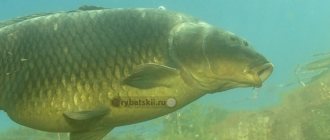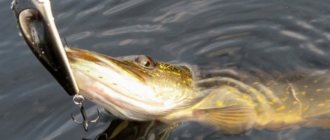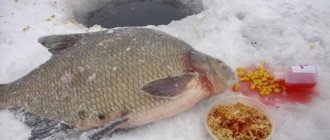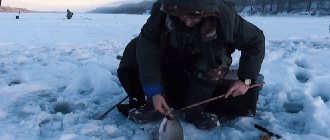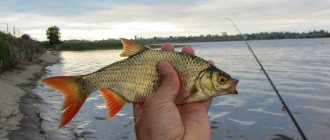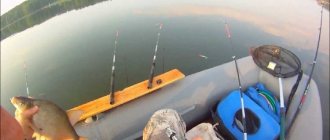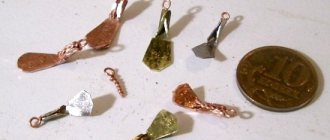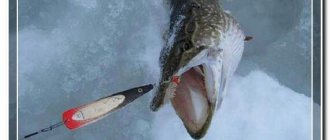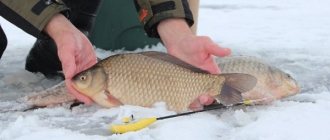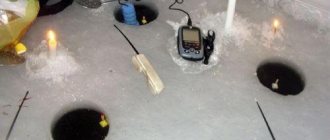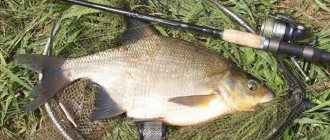The installation of winter gear for bream is selected depending on the fishing conditions. In this publication we will take a closer look at winter fishing rods for bream with a float and a nod. It is advisable to use such gear in conditions of low current or its complete absence. Each method has its adherents, and both work provided that other aspects of winter bream fishing are observed.
Winter bream fishing
There are many ways to catch bream in winter, depending on the set of conditions of reservoirs - depth, strength of current, habits of fish in that particular place. Each angler prefers his favorite fishing methods, using personal experience and knowledge. Consistent and successful fishing for this fish is a sign of high skill. A specific tackle for catching bream in winter cannot be called the best or the worst - they all work under certain conditions, it is important to make the right choice, think through fishing strategy and tactics.
The main thing for catching this representative of fish is to find a feeding school, and only then the correct selection and use of gear for winter bream fishing comes first. Bream fishing in winter is an interesting and creative process; it is impossible to predict the result in advance. At the same time, you can often find a good winter bite and catch to your heart's content.
Types of fishing rods
Gear for catching bream in winter is a kind of variable that is adjusted to the fishing conditions. On one reservoir, one winter equipment will work, on the second, another installation will work better. There is absolutely no catching gear for bream in winter as such. Selecting the right fishing rods is one of several success factors that needs to be adjusted to match the others. The catch factor can be the sum of the moments together with the experience and skill of the fisherman and his correctly configured fishing rods:
- The right choice of reservoir and time.
- Search for trails, winter stopping places and feeding areas.
- Correct selection and installation of gear.
- Feeding system, bait, method of presentation.
- Lack of noise, careful behavior on ice - adult individuals are timid and careful.
Common gear for winter bream are ordinary float or nod fishing rods with various equipment. Their installation is easier and more accurate than winter bottoms designed for fishing in strong currents. On slow-moving reservoirs, lakes and rivers, rods have a competitive advantage over coarser, fast-water gear. This is especially true in the dead of winter, when the fish takes the bait carefully and throws it away at any suspicion or inconvenience.
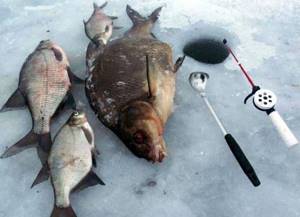
Catching bream on a float in winter
Before we start collecting gear, let's find out some information about bream.
To say that bream is a cautious fish is not enough. Bream is very shy. This is especially true for adult individuals, for whom discretion comes first. That’s why they prefer depths, where it’s not so easy to fish them out. Any even minor noise can deprive a fisherman of a bite. Large fish have a phenomenal ability to sense even sound vibrations transmitted along the fishing line and move away from a dangerous place.
Fishing rod with float
A winter fishing rod for bream with a float is used in any conditions, if the strength of the current allows. The main feature of winter rigging for bream is determined by the depth of the intended fishing spots, 5-15 meters. In addition, the current is added. Therefore, installation includes a relatively heavy sinker, but the tackle must remain sensitive and accurate. If the usual tackle for roach is suitable for catching bream, then for catching large fish in deep parts of the reservoir it is necessary to use a more thoughtful installation of winter float rod equipment for bream.
Fishing rod
The fishing rod itself for winter float tackle for bream is of secondary importance - as long as it is convenient for the angler to use the tackle. Store-bought fishing rods with a handle, balalaikas, fillies, etc. are suitable. Often fishermen make such winter gear for bream with their own hands. The whip is standard, with some flexibility for hooking. On such a fishing rod, a guard is not needed, since the bite is determined using a float. It’s good when the fishing rod is equipped with legs - this makes it more convenient to install it in front of the hole.
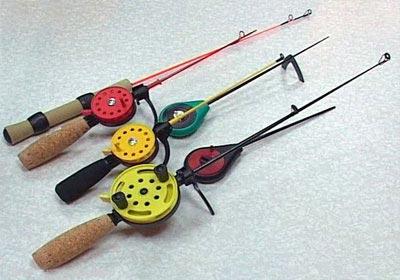
Fishing rods
fishing line
The bream does not resist much when fishing. But large specimens place quite a serious load on the tackle when fishing. In addition, this is a cautious and timid fish. Therefore, it is necessary to use thin, high-quality fishing lines. Winter fluorocarbon monofilament is suitable for these purposes. Sticking to thin lines is a good fishing habit.
In clear winter water, bream may not catch on thick monofilament. More often, fishing line for catching bream in winter is taken with a diameter of 0.12-0.14 mm. For large individuals, a diameter of about 16 - 0.18 mm is used. When the bream takes consistently, thicker rigs of 0.2-0.25 are used. This will show the pond. The choice of fishing line diameter for bream in winter is based on fishing conditions and the behavior of the fish.
Hooks and jigs
Catching bream in winter with a float rod involves using both hooks and jigs in the rig. Hooks are required to be strong and thin, because the bait is a delicate bloodworm. Bream is sensitive to foreign objects in its mouth; it automatically gets rid of them. Therefore, when biting, the fish should not feel the hook itself or the body of the bait (more on this later). The sizes (numbers) of hooks for bream in winter are selected based on the expected trophies, but if the angler is faced with a choice, before making a decision, you need to choose a smaller size. Each fisherman himself develops suitable equipment. Types of installations of float gear for winter bream:
- Equipment with one float.
- With two floats (for greater depths).
- Heavy equipment for current (sliding options or a blind weight at the end with a retractable leash).
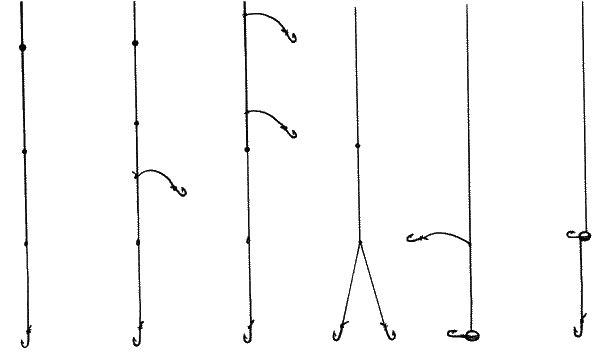
Equipment options
Bite feature
When feeding, the bream sucks in the bottom soil like a vacuum cleaner. By moving its gills, the fish creates a constant flow of water, through which bottom sediments fall into the mouth. Along with the food particles, sand, pebbles, garbage and other inedible objects are also taken in, which the fish immediately automatically spits out, swallowing only food.
Guess what will happen if the fish feels a heavy sinker or jig. The bream will instantly spit out the foreign object automatically - this is a habit of the feeding process, getting rid of inedible particles. Therefore, proper equipment means that the float not only shows the bite, but also unloads the weight of the bait (or jig) during lifting.
It is at this moment, when the float begins to float, that the hook is made. At this moment, the pop-up float pulls part of the weight of the jig (sinker) upward. When the float has completely floated up, this effect ends, the fish will feel the weight of the foreign object in its mouth and get rid of it. This is especially true for large bream, which do not swallow the bait greedily, but eat slowly and tastefully, moving the bottom mass back and forth in their mouths and carefully selecting nutritious particles from among the debris that falls into their mouths.
Therefore, standard winter equipment will only work on active and hungry fish, which rarely happens. In normal feeding mode and with less active biting, sensitive and thoughtful installation is required.
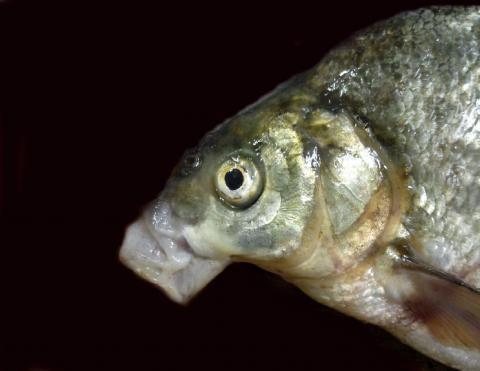
Standard equipment with one float
The equipment of a winter fishing rod for catching bream consists of a main sinker, a hook, a hook and a float. You can use a jig. Winter fishing for bream on a float requires fine tuning of the gear. This lies in the correct selection of the buoyancy of the float and the weight of the sinker with a hook and nozzle or a bream jig. The most sensitive option is two sinkers and a hook, selected as follows.
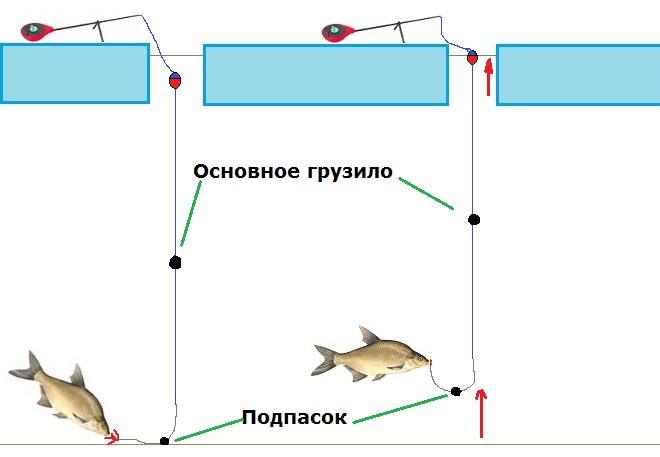
Standard winter float equipment - for any fish from the bottom
The weight of the equipment is selected slightly less than the carrying capacity of the float. The float must be kept on the surface. This is checked by pressing it, as a result of which it goes under water and returns to its original position at an average speed (it does not jump back instantly and does not dangle under water for a long time when overloaded). When you add a backup rig to the installation, the float no longer pulls out the entire mass and sinks. Good tackle for bream in winter should be carefully adjusted.
We noticed that the float (or nod) rises sharply once, but when hooking, nothing happens. This happens because the fish feels the weight of the bait (jig) and immediately gets rid of the foreign object by spitting it out. Fine-tuning the gear eliminates this problem. When you take the bait into your mouth, the slowly rising float takes the weight on itself without alerting the fish. The main thing is to catch it before it completely floats to the surface.
The float deepens not 1.5-2 cm, as usual, but deeper - 5-7 centimeters. This measure will increase the amplitude of the float, the angler will have more time until the fish feels the weight of the bait, since the equipment will float up longer. These manipulations are carried out at home in a container of water, so as not to waste time while fishing on setting up fishing rods.
Equipment for deep waters with two floats
At great depths (over 8 meters), it is better to use a special installation of a winter float fishing rod for bream. Light fishing rod equipment does not work well in such conditions - it sinks slowly, does not straighten out completely, currents in the water column (which are present even in lakes and reservoirs) move the bait or bend the line in an arc, making the gear insensitive.
To overcome this problem, the main sinker is made heavier. A large float is required, but when it rises, it suddenly throws the weight of a heavy sinker, and the fish feels it. Therefore, in the installation of the tackle, another small signal float is placed on top, which is located 5 centimeters from the surface. A large float goes down a meter or more.
The tackle is set up according to the same principle - when you raise the catch, the entire working part begins to float, but the first one to appear from the hole is a small float, which, when lifted, will have virtually no effect on the weight of the bait in the fish’s mouth. The weight of the bait will keep the large float floating up. Composite winter floats for bream work on a similar principle, only faster, leaving the angler less time to think. This type of installation of a winter fishing rod for catching bream is suitable for places without current at great depths.
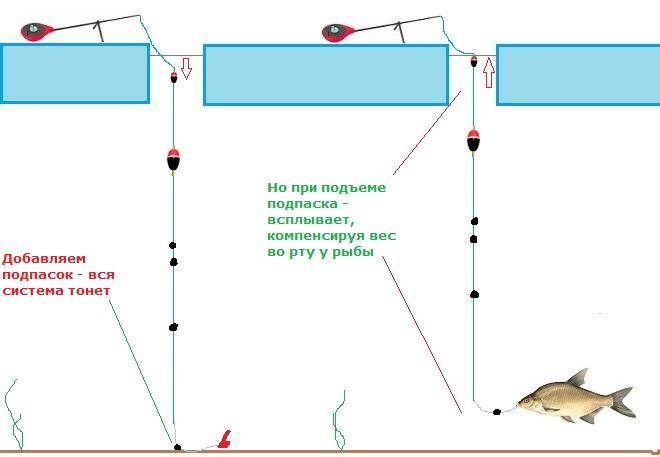
Installation for flow
Equipping a winter float rod for catching bream in the current should solve the problem of the arc of the fishing line, which is formed by the water flow. This bend reduces the sensitivity of the gear. In this case, the sinker and float must be selected for the specific conditions in this particular body of water, taking into account the fishing depth and current speed. The stronger the flow, the more lifting capacity the float is needed in order to better select the arc of the fishing line. The most sensitive installation in these conditions will be with a sliding sinker or a retractable leash. In the latter case, the length of the leash should allow (taking into account the current) the nozzle to lie on the bottom.
Additional equipment
Here I want to talk about the usual attributes of winter fishing, but with some adjustments to the specifics of fishing.
Boer
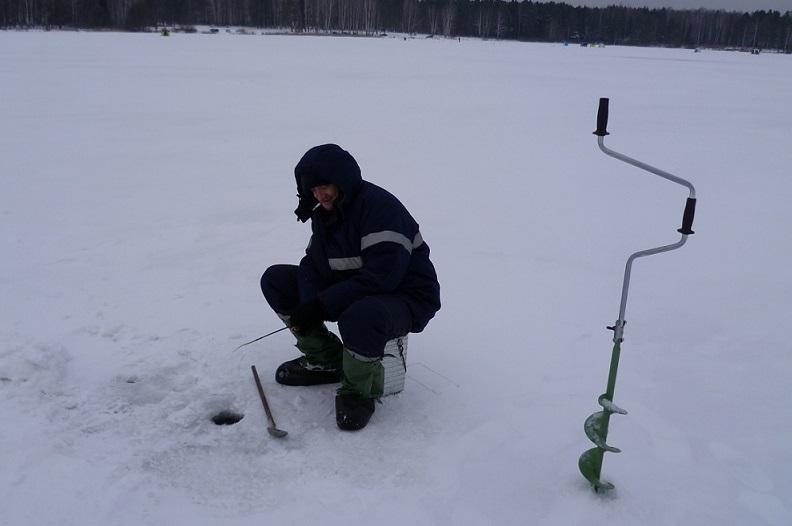
The diameter of the ice screw when fishing for bream should not be less than 130 mm. It is possible to drag individuals weighing about a kilogram into such a hole. If the bream in the reservoir is driven, it can crawl up to 1.1-1.3 kilograms. Here, as a rule, a gaff comes to the rescue.
A bream weighing up to 1.5 kg can already freely crawl into the hole at 150. In addition to the size reserve, the one hundred and fiftieth hole stays a little longer in the cold. The disadvantages of a large diameter include only heavy drilling on thick ice. In the first half of winter, you can use ice screws of large diameters without hesitation. The ice at this time is dry and not particularly thick.
Recommended reading: How to properly catch pike with mugs
If the bream still does not fit into the hole, anglers often resort to a well-known method. The fish is held under the ice with a hook, and another hole is drilled nearby. Then, through the enlarged hole, the trophy is easily removed from the two holes.
In the case where you need to drill a hole quite accurately, a drill with spherical knives will be preferable.
Depth gauge
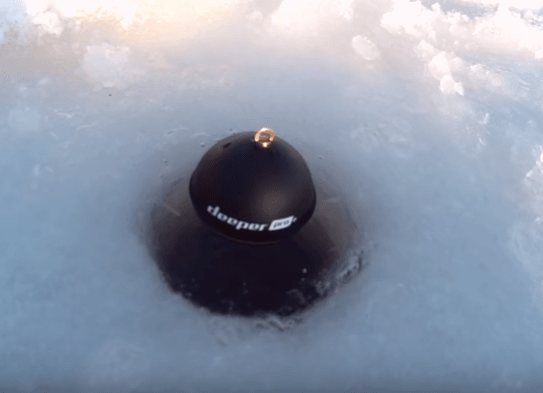
To quickly determine the depth under the hole, you can use an echo sounder or a simple depth gauge:
- Of the echo sounders, it is best to use inexpensive winter models. They often have problems accurately determining the size and quantity of fish. This is due to the insufficient power of the device (we are talking about compact echo sounders that run on batteries). They are quite suitable for accurate depth measurement. Their compactness allows you to carry the device from hole to hole in your clothing pocket, which is convenient.
- A regular depth gauge is made from a rod, reel, thick fishing line and weight. Measuring the fishing line with a tape measure from the weight and up, you can make a knot every meter. It is better to tie a double knot on two meters of fishing line, a triple knot on three meters, etc. This will allow you to quickly recognize the depth of the reservoir, especially if the bottom is not level. As a regular weight, it is better to use a special unhooking hook, which will come in handy more than once when hooking up gear.
Bagorik
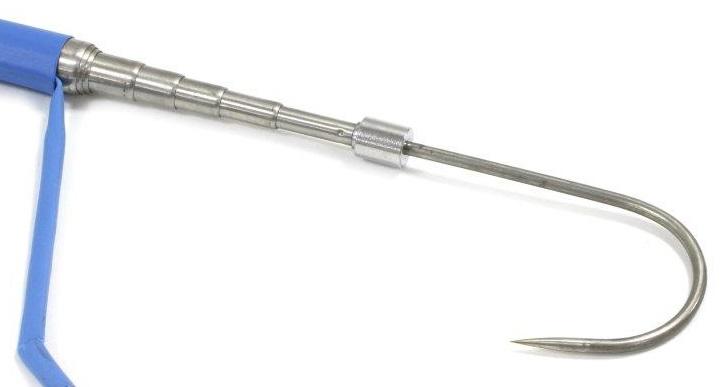
This tool is used relatively rarely; it is better if it has a telescopic handle. When folded, it can be easily transported in a box. It is desirable that, when unfolded, the hook has a length of at least a meter. On thick spring ice, sticking your hand into icy water is very unpleasant, because the thickness of the ice during this period can be more than a meter.
Experienced fishermen always tie a short length of rope to the handle of the hook. In the case when the bream cannot be pulled out even with a hook, and there are no helpers nearby, you can tightly tie the end of the rope to the box and, freeing your hands, begin to drill out the hole with an ice drill.
Skimmer (shabala)
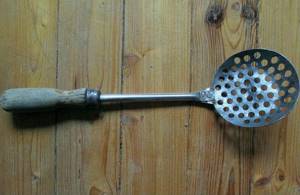
The invention is simple, but there are some nuances:
- I consider stainless steel to be the best material for making shabala. This tool will last a very long time. The edges of the skewer can be slightly sharpened, so it can easily be used to pick out ice-covered holes.
- It is advisable that the handle be made of a lightweight but durable material such as hard foam. If you hold something very cold with your bare hand in the cold, it will quickly become even colder. The lightweight handle will keep the shabala on the surface of the water in case it slips out of your hand.
Checkboxes
To mark their holes, anglers use any suitable material (branches, bottles and other debris). It’s better to spend a little time once and make reliable, bright flags on a 20–30 cm long leg. Holes marked in this way definitely won’t be confused or lost sight of in the snow.
The color of the flags should be as bright and acidic as possible (red, green, orange). The size should be such that the flag is clearly visible in the twilight.
Feeder
Ideally, there should be two feeders. The first is the main one, a “dump truck”, and the second is a small, additional feeding trough. It is important that the feeders open easily, smoothly and do not have any unwanted squeaks. This is especially true for the supplementary feeder, because it often works close to a school of wary bream. Its goal is to feed the fish as carefully as possible.
Recommended reading: Jig rig equipment
Fishing rod with a nod
Many anglers don’t want to bother with fine-tuning the float rig of their fishing rods. That's why they use nodding tackle. The principle of lightening the weight of the bait in the process of taking it into the mouth by the fish is realized by the large amplitude of raising the nod. That is, for this factor to work in winter, you need either a long nod that strongly bends under the weight of the bait, or a reverse-curved one, or a crossbow guard, which also has a large amplitude between the upper and lower positions.
Please note that we are not considering a fishing rod for a jig for game play, but a tackle for catching bream in winter with bloodworms (or other bait) on a riser. Both a jig with bait and a regular hook (with a sinker and a hook) are used as bait.
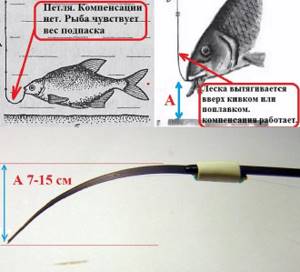
Nodding fishing rod equipment
The standard equipment for a winter fishing rod for bream with a nod is one jig. You can make an additional branch leash or separately higher with an ordinary hook. The options for such winter equipment are different. The main thing is to set it all up so that when installing the nod bends quite strongly, and when the load is released it straightens slowly and with a large amplitude. This will allow the fish not to feel the weight of the bait for some time and give the angler a better chance of being successful with the hook.
Since this is especially true for bream in winter, it is better to use fishing rods with a reverse nod. You can make it yourself by giving the desired bend to an ordinary metal gatehouse. The amplitude between the free and loading positions should be 5-7 centimeters (preferably 7). The nod is selected individually for the specific weight of the jig (hook with a sinker).
A fishing rod for such tackle is equipped with a reel with a large number of fixing recesses (the usual one has 4, but you can cut additional ones yourself) or without them at all (like on a balalaika). This is necessary for precise adjustment of the length of the overhang and setting the nod to the working position.
A rocker arm is successfully used as a winter equipment for fishing rods for fishing in deep soft silt or in stronger currents. Read more about this in the article:
https://podlednik.ru/lovlya_zimoj/zimnie-donki/leshh-na-koromyslo

Rocker
Crossbow
This design was loved by breamers precisely because of the large distance between the lower and upper positions of the nod. A crossbow for catching bream in winter is convenient to use for stationary fishing, but it also allows you to play along a little with bait.
A winter crossbow fishing rod for catching bream can be of any design and is equipped with a reel for precise adjustment of the overhang (and the working position of the guard). Pros of a crossbow:
- Large amplitude of nod lift
- Adjustment for the weight of the jig by twisting the elastic band
- Fixation in the uppermost position when biting. If the angler did not notice and did not hook, after each operation it is necessary to bring the nod back into working condition.
This equipment for winter fishing for bream is equipped in the same way as a regular nodding fishing rod. You can make it yourself. For the base, an ordinary winter fishing rod from the store will do. The equipment is made according to all “bream” rules.

Fishing rod crossbow
Groundbaits, bait
The main and traditional winter bait for bream is bloodworm. Bloodworms are planted in several pieces by hand or with a buncher. Sometimes 2-3 maggots, a sandwich, rather than a bunch works better. The list of possible baits for bream is impressive; any of them may work better in different bodies of water:
- Bloodworm;
- Chernobylnik (burdock moth);
- Mormysh crustacean;
- Caddisfly larva;
- Worm;
- Maggot;
- Mastyrka from peas;
- Semolina mash.
There is information about successful catching of bream in winter using polystyrene foam. It is impossible to recommend any specific bait for bream in winter as the most catchy one. You need to check while fishing what works best at the moment. You need to start with traditional bloodworms, especially if small live estuary is used as bait - this is the natural food of fish.
To successfully catch this fish, it is important to use bait correctly. The best option is live jig (but only in those reservoirs where it lives and forms part of the fish’s diet) or bloodworms. The bream actively searches for these larvae by their micromovements, detecting them with its lateral line even in the thickness of the silt. In the absence of such bait, mixtures based on plant components with flavorings, store-bought or homemade, are used.
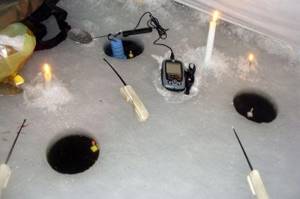
Fishing tactics
Bream is a very cautious, peculiar fish. If an angler does not want to limit his research to catching roach and bream, but relies on large specimens, in winter you need to use the right fishing tactics. The main element is searching for parking areas, trails and feeding points for schools of bream. When we managed to find such places, half the job was done. If the place is unknown in advance, then the fisherman needs to make every effort to search.
In each promising area of the water area, holes are drilled at a sufficient distance (10-20 meters) and fed. Then, after at least 30-40 minutes, each one needs to be caught. You need to be stationary with fishing rods where there are the most bites. Before night fishing, you need to find a place before dark. It wouldn’t hurt to have a park of spare, well-fed holes - the peculiarity of bream biting is that at any moment the flock can simply go to another place.
Suitable places for catching bream on the river in winter
For river bream fishing in winter, choose places with a small or medium current, great depth (at least 4-5 meters) and a hard clay bottom with a small layer of silt.
The most catchy places on the river are:
- The upper edge of the channel ditch within a quiet and wide reach;
- Coastal ditches and their dumps located under steep banks (jams);
- A deep-sea snag submerged in the middle of the river;
- Potholes near the confluence of tributaries (smaller rivers, streams, ditches) into the river.
- Small and deep backwaters, not silted and not overgrown oxbow lakes with depths of at least 5 meters.
You can also often find bream and bream in the watering areas bordering deep holes and ditches. Most often, fish come to such places during the last ice or during long thaws.
Important! Bream does not hold in places with a hard pebble bottom and too fast a current. Just like in the summer, this fish visits dumps inhabited by the river zebra mussel. Similar areas should be marked during summer feeder fishing.
Other fishing methods and gear
In addition to those discussed, anglers also use other winter gear for ice fishing for bream in winter.
Reelless fishing
Catching bream on a nod or nodless fishing rod in winter with a reelless rod has many fans. This group of fishermen is more likely not exactly “breamers”, but adherents of reelless gear for any fish. The method can be used, for example, as an additional method when searching (especially with active fish at the beginning of winter or on the last ice) and stationary fishing. At depth, fishing for bream using devils is popular, due to the large size and heavy weight of this jig. More information about winter fishing with reelless gear:
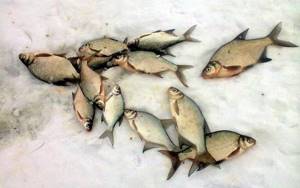
Gear for fishing on currents in winter
For catching bream in winter on the current, a number of special gear is provided:
- Descent (subglacier, combine).
- Ride (ball, twitch, twitch).
- Winter equipment for helicopter.
- Sub-ice winter feeder.
- Equipment with a retractable leash.
- Steam locomotive jigs (garland).
Such gear is effectively used for catching bream in winter on large rivers (Volga, Don, Ob, etc.), where powerful currents and depth do not allow the use of ordinary winter fishing rods.
Subscribe to the channel:
My YouTube channel RYBAFAN on fishing:
We're OK
Bait for currents for bream
When fishing for bream in winter, bait plays a significant role. To deliver it to the bottom, ordinary cone feeders of different sizes are used. The feeder is additionally surrounded if the current is too strong to prevent it from being carried away. To do this, you can attach a lead plate to the lid of the feeder using copper wire, having previously drilled the corresponding holes. Often, fishermen use ready-made vegetable baits intended for winter bream fishing, which are sold in fishing stores.
Read also: Everything about winter bream fishing from A to Z
Before loading bait into a regular cone feeder, it must be moistened with water taken from the hole. If you prepare bait at home, moistening it with tap water, it may have foreign odors, to which bream is very sensitive.
To prevent the plant bait from being carried away by the current, it is mixed with sand or gravel taken from coastal outcrops. Adding bloodworms or maggots to the bait mixture significantly increases its attractiveness to fish. Very often, bream are fed only with small bloodworms, which, however, also need to be weighed down with soil.
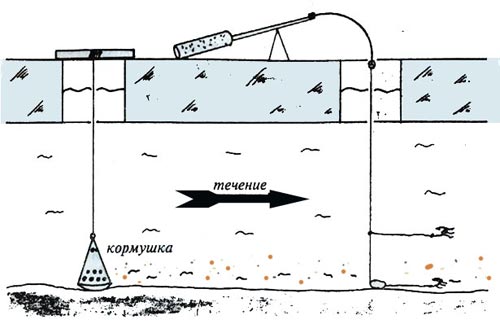
When fishing for bream in the current, it is important to create a feeding path where the bream will approach from afar. The nozzle should be at the beginning of the feeding trail, so the hole for the feeder is drilled about a meter above the hole in which the tackle is placed.
When fishing at a depth of over 6 meters with a strong flow, the distance between the feeding and working holes can be increased to two meters so that the feeder does not drift too far towards the fishing spot. Sometimes, if they feed only bloodworms, the feeder near the bottom is not opened, but is left closed at the bottom during the fishing process. In this case, the holes in the feeder should be large enough so that the larvae are washed out well.
Do-it-yourself bait for bream in winter
When making your own bait plant mixture, it is important to take into account that it contains light particles (breadcrumbs), which will be carried downstream and attract fish to the fishing site, and heavier particles, which will form a feeding path. Keep in mind also that living components (maggots, worms) will create attractive vibrations in the water, and also with their smell will quickly attract bream to the fishing spot.
In winter, you should not get carried away with large plant particles such as steamed millet. It happens that bream leaves the place because the bait used was prepared poorly and began to rot at the bottom, scaring off the fish with an unpleasant odor.
Tactics for feeding bream in the current
Usually on a river, an angler fishes several places that he considers promising for bream to emerge. It is best to use two or three pairs of fishing rods. Having studied the reservoir well in the summer and knowing the places where the flow is calm, where natural food can be carried, holes are drilled taking this into account. Moreover, they choose an area such that promising areas are not very far from each other, no further than 50 m. Having drilled paired holes, they mark them with red flags. A tackle is lowered into each hole, but so that the nozzle is about two meters above the bottom - then it will not be eaten away by small things. Fishing is carried out first on one pair of holes, and if there is no bite within twenty minutes, they change the place of fishing. To do this, you need to prepare your gear in advance.
The choice of each location should be approached carefully. Having sufficiently studied the fishing area and knowing the strength of the current, the direction of the breaker jets, as well as the bottom topography, choose a “point” where the food washed out of the feeder, especially bloodworms, maggots or chopped worms, can linger on bottom obstacles.
